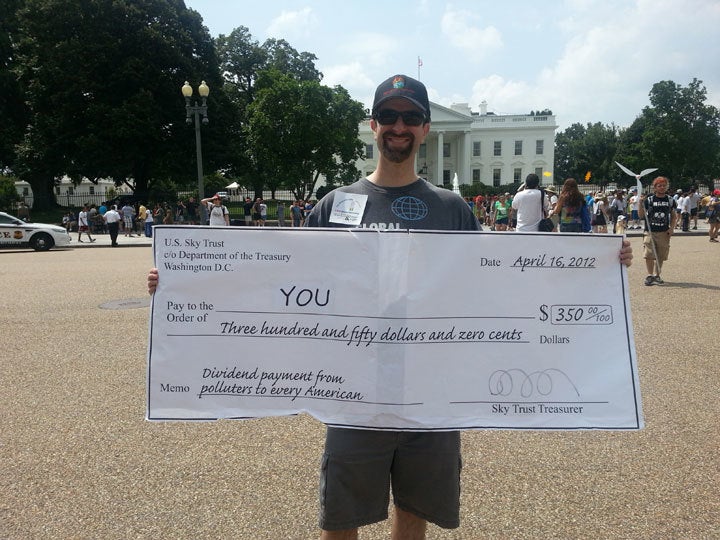
The author outside the White House on July 27, 2013, holding the “Big Div.”
California’s Senate Bill 775 (Wieckowski and de Leon) is a big leap forward for dividend advocacy. The proposal would extend California’s carbon market, simplify its structure by getting rid of questionable offsets, and institute a price collar for market stability. Importantly for dividend advocates, the bill has been described as returning 50-90 percent of revenues to households as climate dividends. But the actual bill language has a blank space where the percentage or dollar amount of dividends would go. Let the wrangling begin!?
For ninety percent of carbon price revenues to be designated for dividends, SB 775 has to pass through the Senate, and then be reconciled with whatever bill passes the State Assembly. Two contenders there are AB 151 and AB 378. The industry-backed AB 151 proposes extending the cap and trade program through 2030. AB 378 focuses on environmental justice and tying the climate program more closely to criteria pollutants in disadvantaged areas. Neither bill talks specifically about dividends, although AB 378 may be compatible with them. The Governor’s position on dividends is unclear. One interesting twist is that California Republicans may join the discussion about climate solutions and what to do with the money. Their votes may not be needed in a Legislature with a Democratic super-majority, but adding the term “bipartisan” to a proposal could add value in marketing a model for national replication. (Note that the bar for “bipartisan” is pretty low. In 2006 AB32 was bi-partisan because Governator Arnold was the lone Republican vote for it, and bills in Congress nowadays can be deemed “bi-partisan” with only a Collins or McCain attached to it.)
As SB 775 wends its way through the legislative process, there will be numerous offers and temptations to compromise on dividends. It can be exciting to join in common cause with people from other political perspectives, but the promise of dividends for all can be co-opted to serve other agendas. For example:
Dividends for Corporations vs. Dividends to People – Beware if conservatives talk about “revenue neutral carbon pricing” but what they mean is using revenues to cut corporate taxes. Remember, corporations are not people. The sky belongs to all of us (humans), not to corporations. Recently there has been a sort of breakthrough among some conservatives, where they have been talking more specifically about sending money to the people. But outside of that group (for example, when Rex Tillerson speaks in support of a carbon tax), dividend supporters should remain on high alert.
Beyond the world of SB 775, but still on the theme of giving people money, here are some other problematic distinctions to be wary of:
The Social Safety Net vs. Basic Income – Occasionally a Libertarian comes out in support of a basic income program, or a huge tech company funds basic income studies. Progress, right? But if they then start talking about getting rid of the social safety net, don’t fall for it. Similarly, watch out if they are looking to use basic income as an excuse to cut benefits for their employees or moving their employees into a “gig” set up (like Uber), or to use basic income to block other measures such as increased minimum wage.
Chickens vs. International Cash Transfers – International cash transfers have been gaining a lot of attention in the field of international development. As climate dividends are to climate change and basic income is to economic and demographic dislocations and insecurities, so giving people money is to international development aid. Researchers have recently stirred up some controversy with Bill Gates’ foundation, which has been promoting chickens instead of cash. Everyone here is well-intentioned, and mostly they are calling for more academic research to solve the dispute, but it just reinforces the difference between the universal climate dividends/ basic income/ cash transfers approach and the chickens or, for California’s cap and trade program, high-speed rail approach.
The Gold Standard vs. Green Monetary Reform – A quick Google search for “monetary reform” will plunge you into a world of conspiracy theories on both the left and right. On the right, monetary reformers want to revert to the anachronistic Gold Standard. This is austerity, where the rich get richer and everyone else will struggle. On other parts of the political spectrum, there are proponents of Modern Monetary Theory (MMT), who would be happy to increase spending and grow the economy with little or no regard for the sustainability implications of infinite economic growth on a finite planet . There is also a small subset of Green Monetary Reformers, including folks like FEASTA (the group behind Cap Global Carbon) and Positive Money, who include long-term planetary sustainability as part of their reform agenda.
Individual Guilt vs. Collective Action for Sustainability – In the broader field of sustainability, individual carbon footprints mostly serve to distract the public from the central issue of collective action to transform whole economic sectors. Individual guilt resulting from focusing only on downstream activities such as taking shorter showers gives the big polluting industries and the corrupted lobbyist campaign financed political system a free pass. Better to stay focused on the system.
As SB 775 makes its way through the political process, dividend advocates shouldn’t count our dividends before they are allocated, but it doesn’t hurt to hope that maybe this time, the time is right for environmental groups, social and environmental justice groups, 2/3rds of the State Legislature, and the Governor to agree that ninety percent dividends in SB 775 is possible!
